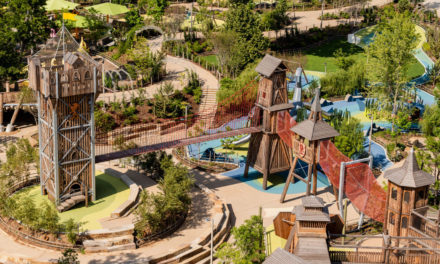Lots of asphalt and hard surfaces welcome people to our riverfront.
We are pleased to see that the City of Memphis has begun a pilot project for Riverside Drive to become a “complete street.”
The test area on Riverside Drive is one mile long from Beale to Georgia. The two lanes on the east side of the median will be open to vehicles, with one lane for each direction. On the two lanes west of the median — closest to Tom Lee Park and the Mississippi — pedestrian space and a two-way bike route will be established.
The vision of Riverside Drive as a complete street was a key recommendation in a report that Jeff Speck prepared at the behest of Memphis Mayor A C Wharton, and we’re really pleased that it’s not just another report sitting on the shelf in City Hall. “Riverside Drive is the highway that was famously killed to become a parkway, but now functions too much like a highway, speeding cars in a seam between the city and its riverfront,” Mr. Speck said.
While the city’s pilot program does not conform precisely to Mr. Speck’s recommendation, city officials said over the next 12-18 months, they will look for any unforeseen problems and seek public input, and we’re hoping that when that process ends – and Riverside Drive is scheduled for repaving – that the Speck recommendation will be implemented.
It’s Not Easy Being Green
The opportunity to add parallel parking and to remove some of the parking out of Tom Lee Park is a persuasive motivator for his proposal. If the mantra, “parks aren’t parking lots,” applies to Overton Park, it should also apply to the largest park on our riverfront.
That said, we commend City Director of Engineering John Cameron and City Bicycle and Pedestrian Coordinator Kyle Wagenschutz for leading this pilot program and for contributing to Memphis’s new green ethos, a transformation that has produced numerous national news coverage at a time when Memphis needs to project a modern, progressive, and healthy image to the world.
Mr. Speck is a city planner and urban designer, former director of design at the National Endowment for the Arts, former director of town planning at Duany Plater-Zyberk and Company (the mother ship for New Urbanism), and co-author of Suburban Nation: The rise of Sprawl and the Decline of the American Dream, co-author of Smart Growth Manual, and his recent book is Walkable City: How Downtown Can Save America, One Step At A Time. Also advising him with the recommendations were transportation planners Nelson/Nygaard, and Toni L. Griffin, urban designer and director of the J. Max Bond Center on Design for the Just City at the City College of New York. .
His entire report to Mayor Wharton was 74 pages but leading his list of six immediately actionable recommendations was “Make Riverside Drive a complete street.”
Looking Back to Look Ahead
To prepare his riverfront recommendations, Mr. Speck analyzed 19 studies and reports dating back 25 years (he said the “last thing Memphis needs is another plan”). He wrote a summary of each one of the prior plans in his report and their recommendations make for interesting reading. “His purpose was to look at everything,” Mayor Wharton said. “It was to pull out the themes that offer the most impact and suggest an agenda for my administration. His report gave me a coherent, complementary vision, and the process to follow it goes on.”
Back to Riverside Drive, Mr. Speck wrote in his summary recommendation: “Riverside Drive, which is annually narrowed and closed with little negative impact on the downtown, should be converted from a four-lane speedway to a two-lane ‘complete street,’ including parallel parking and a protected bicycle track along the Mississippi River. This change can be accomplished through a mere restriping, with no curbs reconstructed. Canopy trees should be added where they are lacking and can be planted at limited cost.”
He called the change to Riverside Drive “potentially easiest win on the Memphis riverfront.” “While a vast improvement over the interstate highway that was once planned for this corridor, it still functions much like a highway, moving four to five lanes of traffic speedily through downtown, creating a high-speed barrier that discourages pedestrian activity and river access. Landscape improvements along Tom Lee Park have already made it more attractive, but have not changed its non-pedestrian nature. Does Riverside Drive need to take such a strictly automotive form?
“The answer to this question can be found each May, when one-half of the street is closed for two weeks and the entire street is closed for three weeks. While presenting some temporary inconvenience as people adjust their paths, it is clear that the City’s grid of alternative north-south streets contains more than adequate capacity to absorb the trips typically handled by Riverside Drive. Such an experience has been mirrored in American cities from coast to coast, where highway removals have repeatedly failed to cause traffic crises. From New York’s West Side Highway to San Francisco’s Embarcadero Freeway, removed road capacity has not had a negative impact on travel times.
For a month each year, Memphis in May reduces the width of Riverside Drive, first by two lanes, then entirely.
People-Centric Planning
“For this reason, and as further studied by transportation engineers at Nelson/Nygaard Consulting Associates, we have the luxury of asking ourselves what kind of street Riverside Drive wants to be. Surely it can still hold cars, but the downtown would benefit tremendously if it were to hold cars moving a bit less speedily, alongside pedestrians and cyclists. Additionally, the inclusion of parallel parking would both provide protection to its sidewalks while eliminating the need for parking lots within Tom Lee Park and at Beale Street Landing.
“These changes, happily, can be achieved without any reconstruction to the street or its drainage facilities; a new topcoat and restriping will be enough. This report’s proposal is as follows:
* Keep the two center travel lanes, as well as turn lanes at intersections, although these turn lanes should be shortened to the length of the typical queue;
* Replace the easternmost lane with parallel parking, clearly marked, and priced to encourage proper occupancy—approaching 80% around the clock. (During many times of day, that price will be $0.)
* Replace the westernmost lane with an ample two-way bike lane, separated by a painted buffer. This buffer should receive inexpensive breakaway metal posts at its center, each about 3 feet high, spaced about 20’ apart.
Fewer Lanes and More Trees
“This proposal is recommended for the entire stretch of Riverside Drive between Bass Pro Drive and Georgia Avenue. An alternative, compromise solution would not place parallel parking any further south than Tom Lee Park, but that solution would require a two-lane-to-one-lane northbound merge in this location. This transition is better handled at Georgia Avenue, where the right-hand lane can become a right-turn lane onto Georgia.
“Since the street varies in width along this stretch, and we wish to limit expense by not moving any curbs, the plans necessarily vary along their length. In all locations, however, two travel lanes are removed and replaced by a lane of parking to the east and a protected bike lane to the west.
“The parking lane receives its own buffer zone in some locations, so that the travel lanes maintain a proper width. The bike facility is located on the western flank because that edge is uninterrupted by intersections for its entire length, close to two miles. Such an uninterrupted path will be especially attractive to bikers, but it is essential that this route is clearly and safely connected to the larger regional biking system.
“Also in need of attention is the tree canopy over the Drive. While prettified in front of Tom Lee Park, it is still more decorative than sheltering. True urban boulevards are planted continuously with a single tall and broad species on both flanks and in the center. At maturity, the top branches of the trees touch, forming a dramatic ceiling. Memphis’ North Parkway, just west of I-240, shows what this configuration is like, and how effectively it contributes to the beauty and comfort of a space. Riverside Drive deserves no less.”
“All you need is a new top layer and paint to restripe it,” he said.




Nice and a big BUT. I can see the slowing down of Riverside and adding parking and bike lanes. And protecting investments like Beale St. Landing. Sounds great. But ever hear of “for every action there is an opposite and equal reaction”. Now cars are jumping off I-55, taking a right on Georgia which in a couple blocks becomes S. Front. Ever see about .5 mile of apartment buildings and condos on S. Front? And 5 more under construction? Yep. That’s right. Those same cars are now speeding thru our neighborhood. Good luck bicycling and crossing on S. Front anymore. Would be nice if the city of Memphis cared about their other assets – the residents.
That’s certainly a commentary on Memphis drivers. They can go straight and get downtown faster than winding through one-lane streets in neighborhoods. We drive this route every day and we can’t imagine ever going through the neighborhoods except when Memphis in May blockage makes us. The test period will allow the city to monitor and see if this problem is serious. Hopefully, MPD should enforce the speed limit and stop any speeding. That’s a problem all over downtown. Thanks for raising the issue.
Maybe for you. But drivers on Front don’t care. You see, there’s only one stop signs/lights from Georgia @ Riverside which dumps people off onto Front street. Not another stop nor crosswalk until Front @ MLK. That’s a very long stretch for only one light/stop and no crosswalks. I live in an apartment on Front street. People are speeding. Increased traffic cuz of reduced lanes on Riverside. I can’t safely ride my bike on Front anymore to get to YMCA. No crosswalks or stops makes crossing the street for me more hazardous than last year. It’s not just Memphis in May. I live downtown. I know. I see it and hear it loudly.
I meant from Georgia @ Riverside (which becomes Front Street) to Front @ MLK, there is only one traffic stop at G E Patterson. That’s 1.25 miles of fast driving.
Sounds like we need to ask the traffic engineer’s office for help on Front.
About 50% more people enter downtown on Front Street, Second or Third than Riverside Drive, so the pilot program will show if any of these people on Riverside shift to other streets. A daily average of 14,235 vehicles go down Riverside while more than 22,000 enter on the other streets. As someone who enters downtown every day on Riverside, I just can’t fathom shifting my entry into downtown from Riverside to Front. The only time I do that is when Memphis in May is blocking Riverside altogether.
Meanwhile, it sounds like there’s a speeding problem that needs to be taken care of.
Thanks for the information.